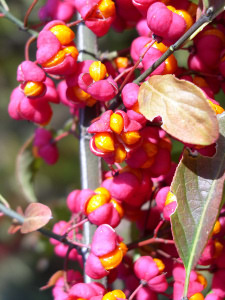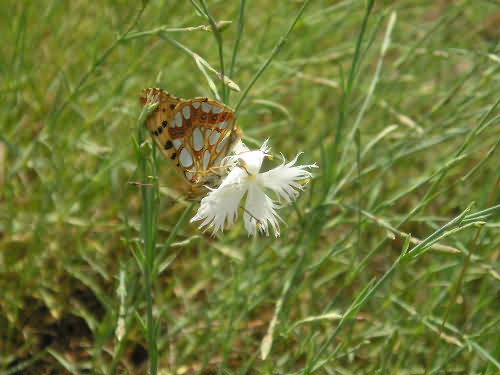Flora
The dryer types of sand oak woods are called steppe oak woods, the more humid, more closed variation is called closed lowland steppe oak woodlands.
Special characteristics of steppe oak woods are the more or less thinning foliage, and the scrub and grass storey developing underneath. In the dryer habitats the woody vegetation alternates with the open, Pannonic sand steppes. At every level rich diversity of species can be found.
The wide crowned Pedunculate Oak (Quercus robur) dominates the crown level of Steppe Oak Woods, but two of our poplar species Grey Poplar (Populus canescens) and White Poplar (Populus alba) are also typical. Less frequent are English Elm (Ulmus campestris), Field Maple (Acer campestris), Wild Pear (Pyrus pyraster) and occasionally Silver Birch (Betula pendula).
Due to the favourable light conditions and the sufficient water supply European Privet (Ligustrum vulgare) and Common Hawthorn (Crataegus monogyna) are frequent at the well-developed scrub level, while Common Hazel (Corylus avellana), European Spindle (Euonymus europaeus) and Blackthorn (Prunus spinosa) also appear.
In the rather shady lowland steppe oak woods the massive presence of Wood Bluegrass (Poa nemoralis) and Slender False Brome (Brachypodium sylvaticum) is typical. Abundant herbaceous plants are Scented and Broadleaf Solomon's-seal (Polygonatum odoratum, P. latifolium), Violet (Viola sylvestris), Creeping Gromwell (Lithospermum purpureo-coeruleum) and Lily of the Valley (Convallaria majalis) also known from home gardens.
 Under the more open steppe oak woods and in the patches of grass between groups of trees species characteristic for Pannonic sand steppe and forests vary: Festuca vaginata, Festuca rupicola, Poa pratensis ssp. angustifolia and Feather Grass species (Stipa spp.). Hungarian Iris (Iris variegata), Bloody Cranesbill (Geranium sanguineum), Sedum maximum, Dropwort (Filipendula vulgaris), Broad-leaved Spignel (Peucedanum cervaria), Wall Germander (Teucrium chamaedrys), White Swallowwort (Vincetoxicum hirundinaria), Germander Speedwell (Veronica chamaedrys) are typical. Sand steppe relict species such as the community importance species Long-lasting Pink (Dianthus diutinus), and Sand Iris (Iris arenaria), Pulsatilla (Pulsatilla nigricans), Achillea ochroleuca, Mountain Germander (Teucrium montanum) and Stipa borysthenica play an important role. Under the more open steppe oak woods and in the patches of grass between groups of trees species characteristic for Pannonic sand steppe and forests vary: Festuca vaginata, Festuca rupicola, Poa pratensis ssp. angustifolia and Feather Grass species (Stipa spp.). Hungarian Iris (Iris variegata), Bloody Cranesbill (Geranium sanguineum), Sedum maximum, Dropwort (Filipendula vulgaris), Broad-leaved Spignel (Peucedanum cervaria), Wall Germander (Teucrium chamaedrys), White Swallowwort (Vincetoxicum hirundinaria), Germander Speedwell (Veronica chamaedrys) are typical. Sand steppe relict species such as the community importance species Long-lasting Pink (Dianthus diutinus), and Sand Iris (Iris arenaria), Pulsatilla (Pulsatilla nigricans), Achillea ochroleuca, Mountain Germander (Teucrium montanum) and Stipa borysthenica play an important role.
|